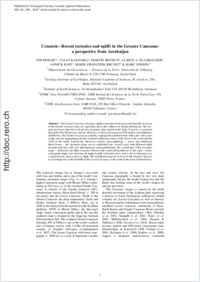Cenozoic-Recent tectonics and uplift in the Greater Caucasus: a perspective from Azerbaijan
- Mosar, Jon Département de Géosciences – Sciences de la Terre, Université de Fribourg, Switzerland
- Kangarli, Talat Geology Institute of Azerbaijan, National Academy of Sciences, Baku, Azerbaijan
- Bochud, Martin Département de Géosciences – Sciences de la Terre, Université de Fribourg, Switzerland
- Glasmacher, Ulrich A. Institute of Earth Sciences, Heidelberg, Germany
- Rast, Annick Département de Géosciences – Sciences de la Terre, Université de Fribourg, Switzerland
- Brunet, Marie-Françoise UPMC Univ Paris06-CNRS-INSU, UMR Institut des Sciences de la Terre Paris, France
- Sosson, Marc CNRS -GeoSciences Azur, Valbonne, France
-
2010
Published in:
- Geological Society, London, Special Publications. - 2010, vol. 340, p. 261-280
English
The Greater Caucasus is Europe's highest mountain belt and results from the inversion of the Greater Caucasus back-arc-type basin due to the collision of Arabia and Eurasia. The orogenic processes that led to the present mountain chain started in the Early Cenozoic, accelerated during the Plio-Pleistocene, and are still active as shown from present GPS studies and earthquake distribution. The Greater Caucasus is a doubly verging fold-and-thrust belt, with a pro- and a retro wedge actively propagating into the foreland sedimentary basin of the Kura to the south and the Terek to the north, respectively. Based on tectonic geomorphology – active and abandoned thrust fronts – the mountain range can be subdivided into several zones with different uplift amounts and rates with very heterogeneous strain partitioning. The central part of the mountain range – defined by the Main Caucasus Thrust to the south and backthrusts to the north – forms a triangular-shape zone showing the highest uplift and fastest rates, and is due to thrusting over a steep tectonic ramp system at depth. The meridional orogenic in front of the Greater Caucasus in Azerbaijan lies at the foothills of the Lesser Caucasus, to the south of the Kura foreland basin.
- Faculty
- Faculté des sciences et de médecine
- Department
- Département de Géosciences
- Language
-
- English
- Classification
- Geology
- License
-
License undefined
- Identifiers
-
- RERO DOC 21088
- DOI 10.1144/SP340.12
- Persistent URL
- https://folia.unifr.ch/unifr/documents/301811
Statistics
Document views: 125
File downloads:
- pdf: 526
